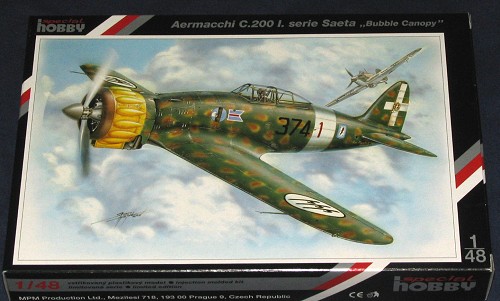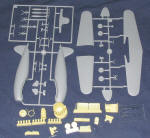
| KIT: | Special Hobby 1/48 Macchi C.200 serie I |
| KIT #: | 48033 |
| PRICE: | $39.95 MSRP |
| DECALS: | Three options |
| REVIEWER: | Scott Van Aken |
| NOTES: | Short run with resin and vacuformed parts |

| HISTORY |
Following the end of Italy's campaigns in East Africa, a program was started to completely re-equip the Regia Aeronautica with a new interceptor fighter of modern design. They were interesting planes powered with a radial engine, with 1-hour endurance, armed with a single 50 caliber (~12.7 mm) machine gun. After realizing the armament was wholly inadequate, they later modified the specification to the also-inadequate two guns. Several companies responded with designs.
At Macchi the design started under the direction of Mario Castoldi, designer of the Macchi entries in the Schneider Trophy races, and thus a direct counterpart to R. J. Mitchell at Supermarine. His design was a completely modern all-metal cantilever low-wing monoplane with retractable landing gear and an enclosed cockpit. One interesting feature was the advanced design for the wing, the hydraulically actuated flaps were interconnected with the ailerons so that when the flaps were lowered the ailerons were drooped as well.
Power was provided by the 840 hp (626 kW) Fiat A.74 radial engine, even though Castoldi preferred inlines and had used them in all of his previous designs. Italian industrial leaders had been instructed to concentrate solely on radials due to their better reliability, but this change may have set back the entire engine industry several years.
The first prototype C.200 flew the day before Christmas in 1937. It was followed by a second prototype early the next year. Testing of the prototypes went smoothly. One of them attained a speed of 500 mph (800 km/h) in a dive, although the puny engine drove the plane to only 315 mph (500 km/h) in level flight. This was nevertheless better than the performance of the competing Fiat G.50, Reggiane R.2000 and Caproni Vizzola F/5, and in 1938 the C.200 won the competition and an initial order for 99 was placed. The G.50 was also placed in limited production because it could be in service earlier.
The C.200 began to enter into service in October 1939, by which time it had been given the name Saetta (Lightning). When Italy entered the war in June 1940, 144 had been delivered and some were in front-line squadrons. The first combat missions were flown as escorts for SM.79's attacking Malta in the autumn of 1940, and the type served subsequently in actions over Greece and Yugoslavia. The Saetta saw extensive use in North Africa and a number were involved in operations on the Eastern Front during 1941-2 where they racked up an impressive 88 to 15 score in that otherwise disastrous campaign.
| THE KIT |
 Special
Hobby/MPM/Azur etc have improved in the quality of their kits over the last
decade or so and the Macchi C 200 is certainly somewhat typical of how
things are going. The two plastic sprues are well molded with nicely
engraved panel lines and a fairly subdued fabric effect on the control
surfaces. No sink areas were readily apparent nor any appreciable flash.
There are the usual ejector stubs on the large bits, but even those are
quite small in comparison to the towers of the past.
Special
Hobby/MPM/Azur etc have improved in the quality of their kits over the last
decade or so and the Macchi C 200 is certainly somewhat typical of how
things are going. The two plastic sprues are well molded with nicely
engraved panel lines and a fairly subdued fabric effect on the control
surfaces. No sink areas were readily apparent nor any appreciable flash.
There are the usual ejector stubs on the large bits, but even those are
quite small in comparison to the towers of the past.
As you might expect, the really difficult to mold and finer pieces are all done in resin. This is superbly molded and probably the only bit that will take some caution in excising from the sprue stub will be the cowling. A rather complex engine bearer assembly is a combination of resin and injected parts and the engine must be built up from a separate crankcase and cylinders. No pushrods or valve cover detail is provided as the latter will not be seen anyway. The nicely done resin cockpit consists of a tub with the rudder pedals already molded in place, control stick, seat with belts and side panels. No fussy little resin control boxes or throttle quadrants to glue in place on this one.
There is no boxed in wheel wells on this one as most of the detail is on the firewall/aft well bulkhead section. Wheel strut and door assembly is rather fussy with three little resin bits attaching to the inside of each main gear door, which then glue to the strut. Two nice vacuformed canopies are provided so that you can display the canopy open if you wish to do some cutting. This one has the resin hub with plastic prop blade set up that I'm less than thrilled about as I don't see why the entire prop can't be done in resin. However, my last kit with this set up worked rather well so I expect this to be equally trouble-free.
 The instructions are
equally trouble-free with well done diagrams and an excellent decal
placement/external painting guide. I will snivel about the paint guide as
this only offers Gunze reference numbers and no generic name, so those of
us who generally don't use Gunze paints have no idea what these colors are.
This is a step backwards and I hope SH/MPM/Azur gets on the stick and
changes this. The decal sheet offers three options. First is the box art
aircraft from 153 Gruppo Autonomo operating in 1941 during the
Yugoslav/Greek campaign. Next are two 88 Squadriglia aircraft, with one
being flown by Italian ace M.G. Baschirotto. Both are in a very complex
multi-color camo similar to what is shown on the box art. The decals are
superbly printed by Aviprint.
The instructions are
equally trouble-free with well done diagrams and an excellent decal
placement/external painting guide. I will snivel about the paint guide as
this only offers Gunze reference numbers and no generic name, so those of
us who generally don't use Gunze paints have no idea what these colors are.
This is a step backwards and I hope SH/MPM/Azur gets on the stick and
changes this. The decal sheet offers three options. First is the box art
aircraft from 153 Gruppo Autonomo operating in 1941 during the
Yugoslav/Greek campaign. Next are two 88 Squadriglia aircraft, with one
being flown by Italian ace M.G. Baschirotto. Both are in a very complex
multi-color camo similar to what is shown on the box art. The decals are
superbly printed by Aviprint.
| CONCLUSIONS |
Another fine short run kit by the folks at MPM and one that should build into a very nice model with minimal hassles. It is a kit that I'd not recommend to a beginner, but those with intermediate skills shouldn't have any problems with it.
Review kit courtesy of my lighter wallet.
July 2005
If you would like your product reviewed fairly and quickly by a site that has around 300,000 visitors a month, please contact me or see other details in the Note to Contributors.